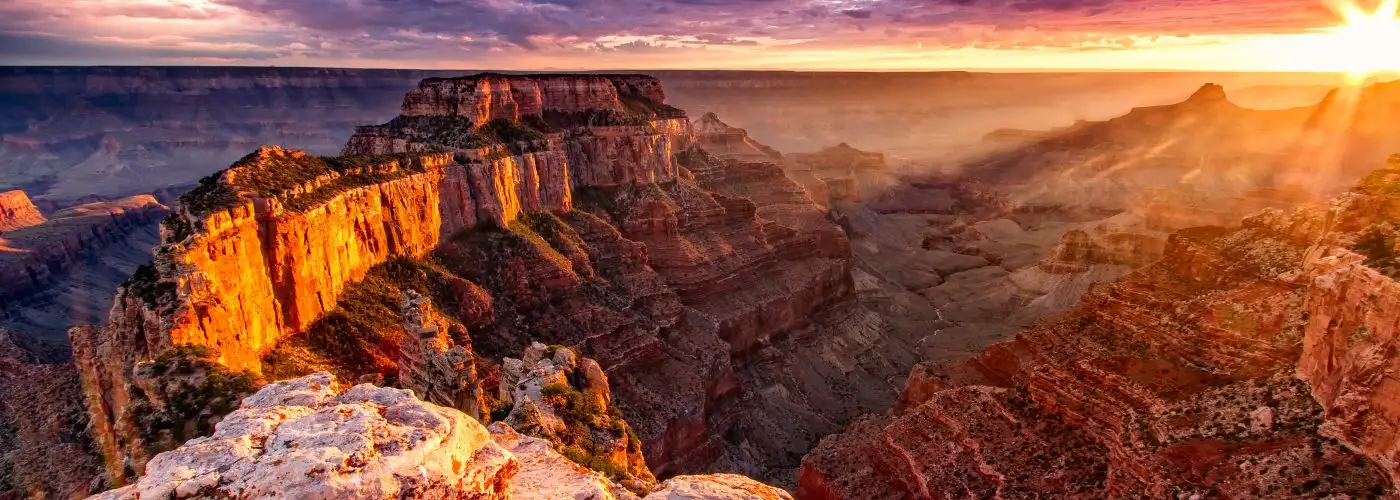“In the Grand Canyon, Arizona has a natural wonder which is in kind absolutely unparalleled throughout the rest of the world,” wrote Theodore Roosevelt. Indeed, though there are wider, deeper, and longer canyons in the world, there is no landscape that is as iconically American as that of the Grand Canyon, one of the seven natural wonders of the world.
While the canyon itself was formed as recently as 5 million years ago, the walls of the canyon—eroded over millennia by the Colorado River—reveal a layered timetable of rock that, at the bottom, is nearly 2 billion years old. Though dammed from above and below, the Colorado River runs uninterrupted for 277 miles through the park.
Grand Canyon National Park welcomes more than 5.5 million visitors each year, second only to Great Smoky Mountains. Roughly 90 percent of visits are to the easily accessible South Rim, which is home to the most overlooks and accommodations. The more remote North Rim sees just 10 percent of visitors, and a scant 35,000 ever make it to the bottom.
Why September Is the Perfect Time to Go
As kids return to school, autumn ushers in relief from the crushing crowds and searing heat of summer. On the higher and cooler North Rim, temperatures mellow and the aspens begin to blaze with gold. On the South Rim, the late-summer monsoons and heat taper off in September, and the shorter days bring a soft, beautiful light to the canyon.
Each September, artists from across the country gather for the Grand Canyon Celebration of Art, where onlookers can watch plein-air competitions over several days, or see art displayed during a month-long exhibition. And the Grand Canyon Music Festival, hosted at the Shrine of Ages on the South Rim, begins in late August and runs through early September.
Why It’s Great at Other Times of Year
If you’re seeking relative solitude, the winter months are by far the quietest. The North Rim is closed by mid-October (and doesn’t reopen until mid-May), but the South Rim and all of its stunning lookout points remain open—but you’ll need to bring warm clothing. Most of the hiking trails on the South Rim remain open, and back-country permits are much easier to come by in winter; just make sure you’re well prepared and know the conditions of the trail you’re headed out on. Like autumn, spring is one of the best times to visit, as the weather begins to warm up but the crowds haven’t yet descended. Summer, of course, is when the park sees most of its millions of visitors. If you plan a summer visit, make sure to book accommodations well in advance, as well as any necessary permits if you intend to hike the back country.
If You Go, Don’t Miss
Of the 5.5 million people who visit the Grand Canyon annually, only a tiny fraction ever make it to the bottom; the 10-mile hike down (and 10 miles back up) is rugged, steep, and challenging. But experiencing the wonder of the inner and lower canyon isn’t completely out of reach if you’re not a hard-core hiker: Consider a mule trip to Phantom Ranch and the bottom reaches of the Grand Canyon through park concessionaire Xanterra. You’ll descend the Bright Angel Trail from the Bright Angel Lodge, and return on the South Kaibab trail. Stay for one ($551.62) or two nights ($788.16); meals are included, as is transportation back to the lodge. Book well in advance, as these trips fill up quickly.
September Bonus Pick: Voyageurs National Park
Early fall is possibly the best time to visit Voyageurs: Minnesota’s only national park. By mid-September the swarming scourge of mosquitoes has mostly subsided, making way for fabulous leaf-peeping as maple, oak, sumac, and tamarisk reach peak color. Voyageurs gets its name from the French-Canadian fur traders who plied these waters, and is made up of several large and many smaller lakes, hundreds of islands, and the Kabetogama Peninsula, whose northern boundary forms a watery border with Canada. Access to most of the park is by boat only, but there are plenty of options—motorboats and houseboats are allowed, canoes and kayaks can be rented at many locations within the park, several resorts offer water-taxi service, and the Park Service operates naturalist-led sightseeing boats that include stops at the historic Kettle Falls Hotel and Ellsworth Rock Gardens.
More from SmarterTravel:
- Glacier National Park: Our August National Park of the Month
- Wrangell-St. Elias: Our July National Park of the Month
- Yellowstone National Park: Our June National Park of the Month
- Olympic National Park: Our May National Park of the Month
- Great Smoky Mountains: Our April National Park of the Month
- Hot Springs: Our March National Park of the Month
- Death Valley: Our February National Park of the Month
- Everglades: Our January National Park of the Month
Deb Hopewell is a longtime journalist and the former editor of Yahoo Travel. She writes for Outside, Fodor’s, Architectural Digest, Travel+Leisure, and others. Follow her on Instagram @debhopewell and Twitter @dhopewell.
We hand-pick everything we recommend and select items through testing and reviews. Some products are sent to us free of charge with no incentive to offer a favorable review. We offer our unbiased opinions and do not accept compensation to review products. All items are in stock and prices are accurate at the time of publication. If you buy something through our links, we may earn a commission.
Related
Top Fares From
Today's Top Travel Deals
Brought to you by ShermansTravel
Kenya: 14-Night Tour, Incl. Tanzania &...
smarTours
 vacation
$7125+
vacation
$7125+
7-Night Caribbean Round-Trip Cruise From Orlando:...
Norwegian Cruise Line
 cruise
$739+
cruise
$739+
Ohio: Daily Car Rentals from Cincinnati
85OFF.com
 Car Rental
$19+
Car Rental
$19+




